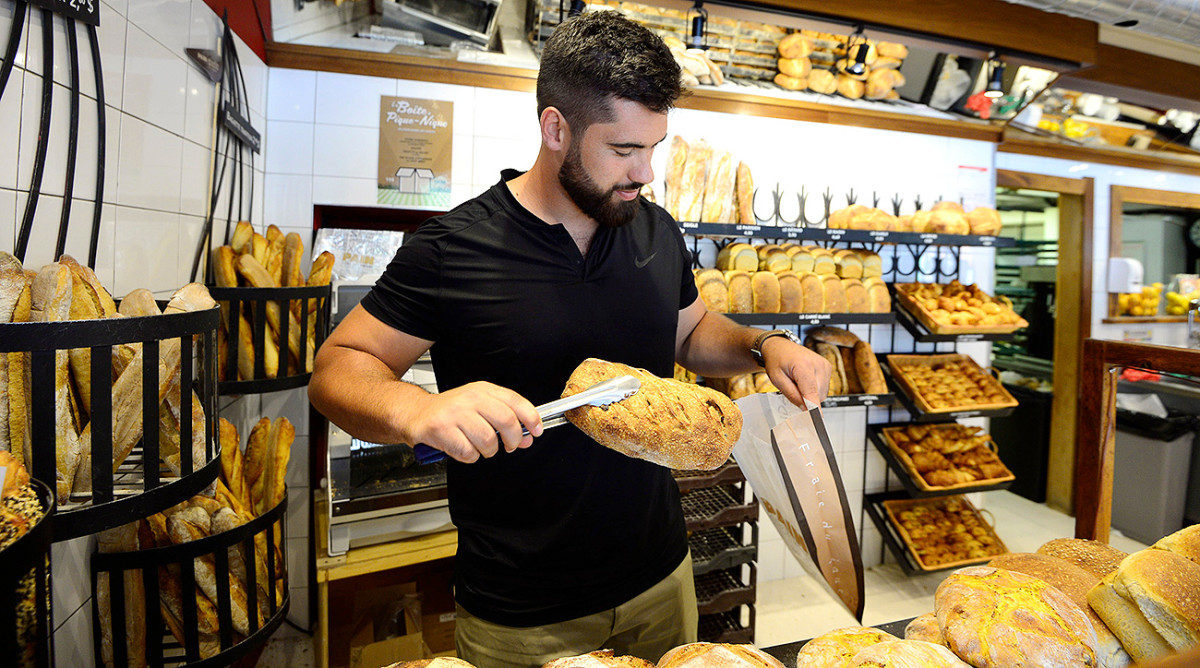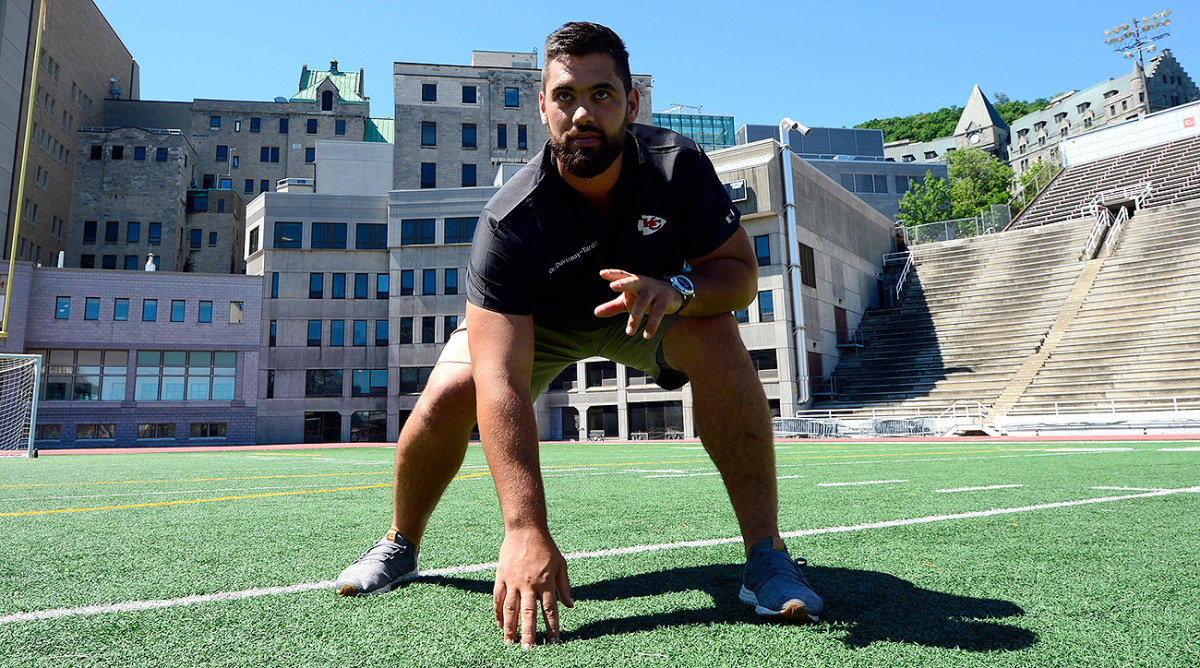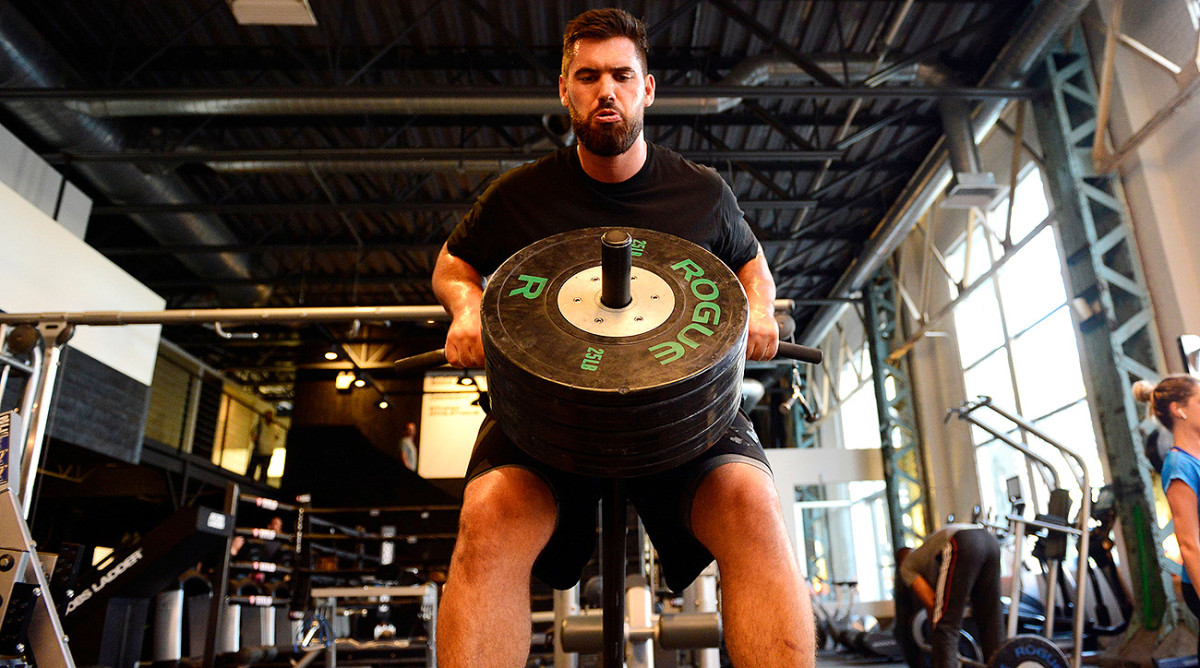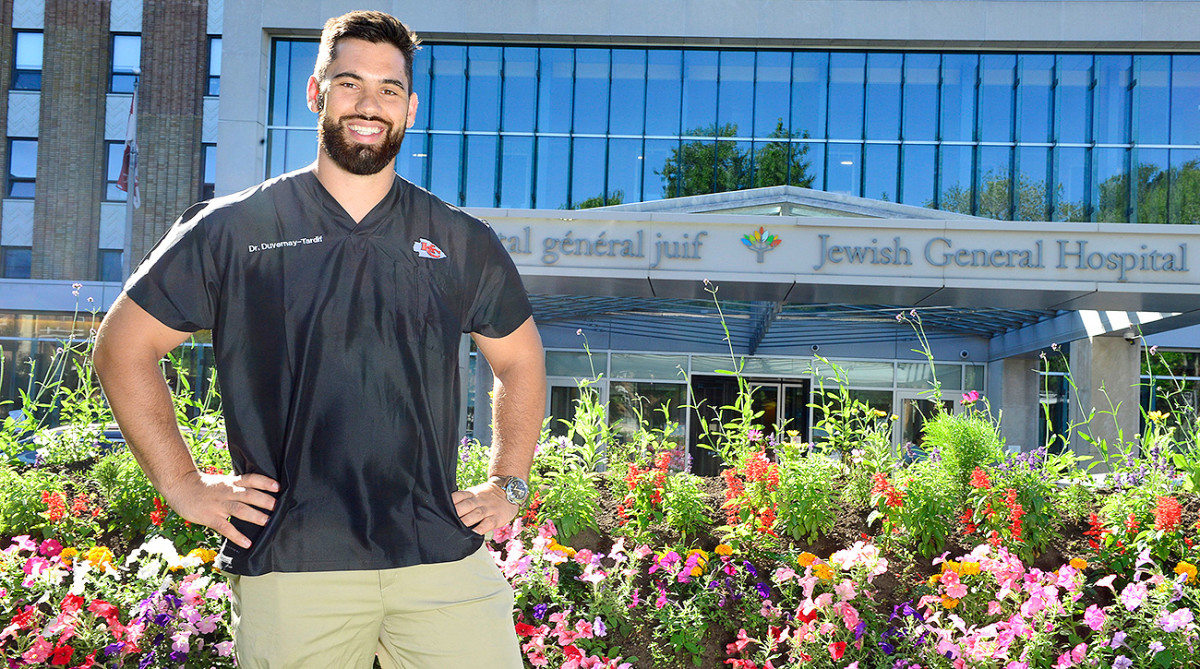Laurent Duvernay-Tardif, M.D.: How the Chiefs Guard Earned His Medical Degree While Protecting His QB

A version of this story appears in the Sept. 10, 2018 issue of Sports Illustrated. For more great storytelling and in-depth analysis, subscribe to the magazine—and get up to 94% off the cover price. Click here for more.
The doctor pulls a white Ford Fiesta across traffic and into the parking lot of a vacant store, calculating his options. The metered area is a bit of a trek, and this space is directly across the street from the hospital, which should save him at least 10 minutes, coming and going. And since the store isn’t open, he figures, no one should care that he’s violating the Customers Only signs.
“You have to balance it,” says Laurent Duvernay-Tardif, who keeps a mental record of how often he gets ticketed—so far this month, only once—and how much time he’ll save by taking the risk. Then he grabs a notepad and a half-dozen bakery bags and hurries across the street to his 2:30 meeting.
As he approaches the building, Duvernay-Tardif realizes he has a couple of minutes to spare, a rare luxury. So he walks into a nearby Dollarama in search of deodorant. Back on the street, he lifts his shirt and applies it in quick strokes, then he enters the Department of Family Medicine and rides the elevator to the third floor.
It is mid-July in Montreal, two months after Duvernay-Tardif graduated from medical school and less than a week before he must return to Kansas City to begin his fifth NFL training camp. Ever since the Chiefs drafted him in 2014, he’s had to balance these two demanding careers. Yet becoming the first active NFL player to be a licensed M.D. was only the beginning. The question he hopes will be answered during today’s meeting is: What’s next?
An assistant ushers Duvernay-Tardif into a glass-walled waiting room, where he squeezes his 6' 5", 321-pound frame into a narrow cloth chair. He’s told that the two doctors—one, the department chair; the other, in charge of the postgraduate program—will be with him shortly. The six bags of bread and assorted goodies that he brought over from his parents’ bakery, where he helped knead dough earlier in the day, are placed on the table. He plans to pass them around the office. “You make more friends when you give out pastries,” he says in mellifluous English accented by his native French. His way of speaking, paired with his immaculately groomed beard and academic mien, makes it seem as if he’s always doing something important.
As he waits, Duvernay-Tardif tries to recall the details of his NFL contract and begins to enumerate his various residency options, attempting to untangle their potential conflicts and accompanying unknowns. At 27, he doesn’t know how long his career as a right guard will last—or how long he wants it to. He understands the dangers of the sport all too well, and he’s constantly asking himself if it’s still worth it to play.
When he disrupted his medical school studies four years ago, Duvernay-Tardif faced long odds to make it onto an NFL roster from a Canadian university. He never considered the possibility that, once he graduated, he’d be a mainstay on a Super Bowl contender in the midst of a five-year, $42.4 million contract. But now he worries that he’ll have to wait until his NFL career is over to begin his residency. By then, he fears he’ll have forgotten everything he learned in med school.
The assistant returns and escorts Duvernay-Tardif down the hallway. He turns a corner, enters an office and closes the door behind him.

Laurent Duvernay-Tardif has always been comfortable in the unknown. When he was 12, his family embarked on a yearlong sailing trip, their 30-foot boat going up the St. Lawrence River from Montreal and then traveling down the East Coast—Boston, New York, Delaware Bay, Chesapeake Bay, Miami—before eventually taking the Gulf Stream to Turks and Caicos and the 700 islands of the Bahamas.
It was a voyage that had been two decades in the making, ever since Laurent’s father, François Tardif, had mentioned the dream on his first date with Guylaine Duvernay, over coffee and tea. In 2003, with three kids and no sailing experience to speak of, François quit his job teaching agriculture and put to sea. Their youngest, eight-month-old Marilou, took her first steps on the boat, in the circumambient waters of the Atlantic Ocean.
“You can have so many dreams,” François says. “But they don’t mean anything if you don’t do them.”
Laurent, their eldest, steered the boat, interpreted tide charts and monitored the radar. They ate only what they caught, so Laurent would put on a wetsuit, fill his belt with lead to sink in the water, grab a scuba mask and spend four hours a day searching for grouper and tuna, teaching himself to spearfish. If he threw the spear too hard, it would go through the fish entirely and he’d lose the weapon; too soft and the fish swam on, taking the spear with it. Laurent quickly realized the importance of tide direction—fish blood flowing toward deeper waters could attract unwanted visitors. “Learned that after seeing a few 15-foot-long sharks,” he says.
Shaquem Griffin, His Mother, His Debut, and the Tour of What’s Possible
The children were homeschooled on the boat, with Dad handling the sciences and Mom the humanities. Sometimes they’d dock at an island for a day and the kids would be dropped off at a school where no one spoke French, just for the experience. On the beach, they’d collect palm tree branches, build a fire and grill what they had caught. At night they returned to the boat, where Laurent would open a latch in the cockpit and sleep in a box not much bigger than he was.
Three years later they set sail again, a reprise of the first trip. Shortly after they returned, Laurent’s paternal grandfather passed away. Guy Tardif had been an intellectual, a professor, a politician, an entrepreneur. He received a master’s in criminology, lectured at the University of Montreal, did research for the Quebec Ministry of Justice, published articles on the penitentiary system and prison reform, and was elected as a minister of Quebec—running the departments of consumer affairs, planning and housing, and transport. “And he could hold a hammer and do electricity, too,” Francois says. In the late 1970s and early ’80s, Guy worked in the government of René Lévesque, the founder of the Parti Quebecois. After serving for nine years—and narrowly failing to achieve the party’s goal of winning Quebec its sovereignty—Guy left politics and bought a cornfield on the south shore outside Montreal. With no training, he spent years planting grape vines and apple trees; soon his winery-orchard became locally renown.
After his father died, François sold the winery and spent three months in France studying culinary arts. When he got back home, he and Guylaine opened a bakery in Mont-Saint-Hilaire, an hour east of Montreal. They called it Le Pain dans les Voiles, Bread in the Sails, and in 2011 they won second place at a world bread competition in France. “We are independent,” François says. “Do you see that?”
Laurent has always embraced the family ethos. When he was 13 he planted basil, collected it in the fall, made bottles of pesto and sold them at farms. A year later, after watching a YouTube video, he bought 100 day-old chickens, built an enclosure, raised them, slaughtered the 70 that survived, calculated his costs and sold the poultry for $6 a pound.
Wanting money to vacation in Italy after his freshman year of college, Duvernay-Tardif made, bottled and sold fruit jam and caramel in his parents’ bakery. He and his new girlfriend, Flo Dubé-Moreau, were able to travel for a month. During his first season in the NFL, Duvernay-Tardif taught himself woodworking and built Flo a desk out of pinewood. Last February, just weeks after the Chiefs lost in the first round of the playoffs, he fulfilled a lifelong dream of going to the Olympics—but he wasn’t a spectator in PyeongChang. Instead, the Canadian Broadcasting Corporation hired him to report, write and produce 15 stories on the intersection of sports and science. “He needs to push his limits,” Flo says. “That’s really central, the core of who Laurent is.”

Duvernay-Tardif began playing football when he was 14, but only because he’d gotten too big for hockey and a friend’s mother suggested he give it a try. He had never watched the sport before, knew nothing about it and quickly learned that he wasn’t very good. But he enjoyed the cerebral aspects of the game—the physics, the angles, the strategy—and played for his city’s team. His grades in high school were exemplary and earned him entrance to a CEGEP—a two-year program in Quebec that essentially combines senior year of high school with a focused undergraduate study. By then he had already decided on a life in medicine.
There are four medical schools in Quebec, three French-speaking and one English. Because he entered the wrong date on his calendar, Duvernay-Tardif missed the entrance exam for the French schools and was forced to attend McGill. At the time his English was halting. When he first got to the school he had to watch recordings of his classes at half speed while flipping through a pocket dictionary just to keep up. On the advice of guidance counselors, he didn’t initially join the football team in order to focus on his studies.
Away from the sport, he felt restive. His mind raced. His grades suffered. “I realized then I need football in my life to balance it,” he says. “If I stop one or the other, I am done.” A desultory month passed before he joined the team. He became a backup defensive lineman while also taking 30 hours of classes a week and dissecting cadavers. “You get there late at night, alone, 50 dead bodies on tables, it was a little creepy,” Duvernay-Tardif says.
At the start of his sophomore year the team needed more offensive linemen and Duvernay-Tardif was asked to switch positions. He proved a natural. During his first practice Matthieu Quiviger, the team’s O-line coach and a former first-round pick in the CFL, told Duvernay-Tardif that he had a chance of playing in the NFL. Others on the staff laughed. “When the midget league coach saw Gretzky on the ice for the first time,” Quiviger says, “I’m sure he knew he had something special, too.”
Aaron Rodgers’ Magic Caps a Wild First Sunday
In his final two years at McGill, Duvernay-Tardif worked upward of 70 hours a week in the hospital, doing a different rotation every few months—family medicine, internal medicine, emergency, psychiatric, pediatric, surgery, ophthalmology. During the season, he selected a different day each week that he was able to attend practice. Sometimes he’d work the night shift at the hospital and sleep on the locker room floor afterward, scrubs still on, his head resting on a pile of pillows, until the team’s 6 a.m. meeting. With no time for meals at the hospital, Duvernay-Tardif would stuff his pockets with hard-boiled eggs and crack them open against the elevator door on his way to see patients. Or he’d take Ziploc bags filled with protein powder, add water and squeeze the concoction directly into his mouth.
Anytime Duvernay-Tardif encountered a challenging case—a patient needing water drained from his lungs, or one with pneumonia needing her vocal cords temporarily paralyzed in order to shove a tube down her larynx—he would invariably stay after his shift to witness the technique or procedure. When he finally left the hospital, the sky dark and his teammates asleep, he’d take off his scrubs and head to the gym to train.
He won McGill’s Champions Award for combining athletic prowess with academic excellence, maintaining a GPA near 4.0, and also the J.P. Metras Trophy for being the most outstanding collegiate lineman in Canada. “He improved so fast,” Quiviger says. “Dominated people so badly.” Heading into his fourth season, Laurent realized there was a chance, albeit slim, that he could become the 10th Canadian university player ever drafted into the NFL. He wouldn’t have been a Duvernay-Tardif had he passed up the opportunity.

In the winter of 2014, Duvernay-Tardif took four months off from medical school and stayed with trainer Charles Petrone in Knoxville, Tenn., working out at his Wood Gym with a small group of NFL hopefuls. There, Duvernay-Tardif prepared crepes for the house; slow-cooked a beef stew; baked a delectable cheesecake; studied his medical books; dominated everyone in Ping-Pong; chastised other players for not putting away their dishes; and displayed his vast but raw potential in the gym.
“He’s a renaissance man,” Petrone says. “I was like, Jesus, Laurent, what can’t you do?”
Not invited to the NFL combine in Indianapolis, Duvernay-Tardif hosted his own pro day at a soccer stadium in Montreal; nine teams showed up and watched him broad-jump 9' 6" (which would have ranked second among O-linemen at Indy), run the 40 in 4.94 (fourth), bench press 225 pounds 33 times (seventh) and post a 31 1/2" vertical (third). NFL interest began percolating, even though Duvernay-Tardif was still in medical school. He brought a packed suitcase to the hospital every day so he could hop on a flight when teams called, beckoning him for a predraft visit. At one point the offensive line coach from the Eagles pinged him for a Skype session, which he took in a bathroom stall during a break from seeing patients.
Duvernay-Tardif had watched only a handful of NFL games—he bought his first TV after getting to the league and still doesn’t have cable—and his knowledge of the sport didn’t extend far beyond Tom Brady’s name. His agent and best friend, Sasha Ghavami, would send him Word documents containing the most basic information—the coach of the team he was visiting, its star players—that Duvernay-Tardif would study on the flights.
On the second night of the draft Duvernay-Tardif didn’t show up to the house party that Ghavami hosted in his honor: He’d had a chance to scrub in during an emergency C-section, for twins no less. Chiefs coach Andy Reid and general manager John Dorsey called the following day, informing Duvernay-Tardif that they were taking him in the sixth round. The team needed him in Kansas City the next day; Duvernay-Tardif had a pediatrics exam the next week. He was able to reschedule the test, establishing the blueprint that would allow him to spread his final year of medical school out over four NFL offseasons.
How Patrick Mahomes Won Over Andy Reid and the Chiefs
That was the easy part. Now Duvernay-Tardif had to learn what amounted to a new sport. Canadian football is played with 12 men, three downs, wider fields and unlimited forward motion. Because the defensive line is required to play a yard off the ball, the footwork for offensive linemen is fundamentally different. And, of course, there were cultural adjustments to be made for a player who had practiced just once a week for the past two years. His position coach in K.C. would say things in meetings like, “O.K., if we are in a backed-up situation, this is what . . . ” and Duvernay-Tardif would raise his hand and ask, “What is the definition of backed-up?” Or, “This play is in the draw family . . . ” and a confused Duvernay-Tardif would say, “Draw family?” He was so lost by the end of his first training camp that Reid asked him if he had ever played football before.
Duvernay-Tardif made the final roster, asking teammates to call him Larry because he was tired of them butchering Laurent, but he didn’t suit up for a single game that season. He had to learn not only whom to block, but also how. He spent practices off to the side working on basic footwork, repeating the steps over and over. He also watched film for the first time, breaking down technique and taking notes just as he would in medical school. Often he would take a piece of paper and scribble a half dozen lines of scrimmage on it, drawing different defensive fronts because he didn’t understand the difference between a base look and a sub look. He had to learn concepts like safety rotation and acronyms like EMOL (end man on the line of scrimmage).
At the end of the season, the same day that he had his exit meeting with the team’s coaches, he drove back to Montreal, 24 hours straight, and switched lives. His shift in the psychiatric hospital was waiting. To transition, he spent the ride listening to erudite podcasts: Freakonomics Radio, The Economist and Aujourd’hui l’histoire, a French program that details the life of historical figures. “The hardest thing every year,” he says, “is to go from being a football player to being a medical student.”
After two months in psychiatry, followed by a month each in gynecology and obstetrics, Duvernay-Tardif returned to Kansas City for his second season and quickly earned the starting right guard job. He hasn’t relinquished it since, becoming one of the best blockers on one of the league’s best lines. And his ability to get out in space and take on second-level defenders has proved to be an integral component in Reid’s multifaceted running game.
As he ascended on the field, Duvernay-Tardif was still heading back to Montreal every offseason to continue his studies—internal and emergency medicine after his second season, geriatrics after his third. It was then that Kansas City made him the fourth-highest-paid guard in the league, and something of a celebrity back in Quebec. “But,” Duvernay-Tardif says, “in geriatrics everybody is too old to recognize you.”
This past offseason, with classes finished and just the final exam left, he traded a bloody, game-worn Chiefs jersey to Quiviger for the use of his old coach’s cabin deep in the Val-Morin woods, 60 miles northwest of Montreal. For three weeks he woke up at six in the morning, flipped through a four-inch-thick binder stuffed with some 1,300 pages of notes, did ladder work with elastic bands in the kitchen, kettlebell lifts and medicine-ball throws outside in the snow, and then stopped to watch the sun set beyond the mountains. He passed the test on May 8, graduated from medical school on May 29, and was at Chiefs practice the next day.

In the third-floor office of the Department of Family Medicine, Duvernay-Tardif and the two doctors attempt to put together a plan. The group decides that his best course is to enroll in the two-year family medicine program, since it will allow him the most flexibility. After he finishes, he’ll be a primary-care physician, able to start his own practice. If he wants to then add a year of emergency or sports medicine specialization, he’ll have that option, too.
There are still several variables though. Most of family medicine focuses on “continuity of care,” meaning a doctor must treat the same patients consistently over an extended period of time; right now, Duvernay-Tardif is only able to work three or four months a year. But the doctors say the department would be willing to condense the eight months of “off service” work that do not require continuity of care—pretty much the standard hospital rotations that he did in medical school—over three NFL offseasons. Once complete, Duvernay-Tardif would have to become a full-time resident, effectively capping his football career.
More variables. Duvernay-Tardif wants to ensure that he’ll be able to honor the contract he signed with the Chiefs, which runs through 2022, with guaranteed money fully paid out in ’20. The doctors inform him that he can wait up to four years before he is required to begin the residency program. But once he starts, he has only four years to finish it. He makes calculations—the years left on his deal, the odds that he might get cut early.
Once his current deal is up Duvernay-Tardif will have played nine years in the league—a long, distinguished career, he notes. Still, he doesn’t want to rule out the possibility of signing another contract. But the longer he stays in the game, the less medical school knowledge he will retain. Frequently he says that the most important factor in all of this is being a competent and well-respected physician once he retires from football.
An hour later, the three men exit the room; the department chair tells Duvernay-Tardif that he wants tickets to the Super Bowl should the Chiefs make it this year. Duvernay-Tardif laughs as he passes out the bags of pastries. But he doesn’t linger for too long; he still has a workout to fit in tonight.
There is still much to debate and decide, but he feels encouraged. Will it be difficult? Of course. Impossible? That’s not a word the Duvernay-Tardif clan uses. For the past 5½ years, Duvernay-Tardif explains, his father has been building a 40-foot sailboat, by hand, in the family’s front yard, using plywood and epoxy, melting two tons of lead and pouring it into a sand mold to make the keel. Next week, Francois will take the boat out onto the water for the first time. At one point that may have seemed impossible, too.
There is another factor in Duvernay-Tardif’s decision, of course, and that is the rather paradoxical concept of a healer playing football. He doesn’t deny or downplay the dangers of the sport, but he believes the league has taken positive measures to address the issue of head trauma. When he’s told that there’s only so much you can do to make an inherently violent game safer, he doesn’t disagree. Instead, he says that every time he sustains an injury—a left MCL sprain in 2017, a concussion the year before and another last month—he asks himself if it is still worth it. And every time, the answer has been yes.
He has opportunities now—conversations with NFLPA doctors, the possibility of opening his own clinic and sitting on various boards—that wouldn’t have been possible four years ago. When he transitions to medicine full-time, he believes his profile as an NFL star will allow him to be more beneficial to society. “When I say it’s worth it,” Duvernay-Tardif says, “it’s all of that.”
He crosses the street and unlocks the car, placing his notebook in the backseat while searching for his workout clothes. As he sits behind the wheel, he enters an address into his phone’s GPS to figure out how he can best get to where he is going next. He checks his rearview mirror and then looks toward the horizon. The road is open, the destination known. And on the dashboard, there is no ticket.
Question? Comment? Story idea? Let us know at talkback@themmqb.com.
